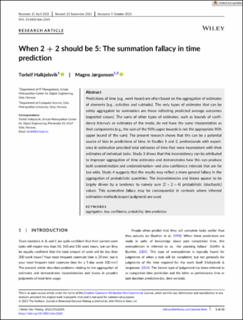| dc.contributor.author | Halkjelsvik, Torleif | |
| dc.contributor.author | Jørgensen, Magne | |
| dc.date.accessioned | 2022-08-30T12:10:00Z | |
| dc.date.available | 2022-08-30T12:10:00Z | |
| dc.date.created | 2021-12-02T13:15:12Z | |
| dc.date.issued | 2021-11-10 | |
| dc.identifier.citation | Journal of Behavioral Decision Making. 2021, . | en_US |
| dc.identifier.issn | 0894-3257 | |
| dc.identifier.issn | 1099-0771 | |
| dc.identifier.uri | https://hdl.handle.net/11250/3014386 | |
| dc.description.abstract | Predictions of time (e.g., work hours) are often based on the aggregation of estimatesof elements (e.g., activities and subtasks). The only types of estimates that can besafely aggregated by summation are those reflecting predicted average outcomes(expected values). The sums of other types of estimates, such as bounds of confi-dence intervals or estimates of the mode, do not have the same interpretation astheir components (e.g., the sum of the 90% upper bounds is not the appropriate 90%upper bound of the sum). The present research shows that this can be a potentialsource of bias in predictions of time. In Studies 1 and 2, professionals with experi-ence in estimation provided total estimates of time that were inconsistent with theirestimates of individual tasks. Study 3 shows that this inconsistency can be attributedto improper aggregation of time estimates and demonstrates how this can produceboth overestimation and underestimation—and also confidence intervals that are fartoo wide. Study 4 suggests that the results may reflect a more general fallacy in theaggregation of probabilistic quantities. The inconsistencies and biases appear to belargely driven by a tendency to naïvely sum (2+2=4) probabilistic (stochastic)values. Thissummation fallacymay be consequential in contexts where informalestimation methods (expert judgment) are used. | en_US |
| dc.language.iso | eng | en_US |
| dc.publisher | Wiley | en_US |
| dc.relation.ispartofseries | Journal of Behavioral Decision Making;Volume 35, Issue 3, e2265 | |
| dc.rights | Navngivelse-Ikkekommersiell 4.0 Internasjonal | * |
| dc.rights.uri | http://creativecommons.org/licenses/by-nc/4.0/deed.no | * |
| dc.subject | Aggregation | en_US |
| dc.subject | Biases | en_US |
| dc.subject | Confidence | en_US |
| dc.subject | Probability | en_US |
| dc.subject | Time predictions | en_US |
| dc.title | When 2 + 2 should be 5: The summation fallacy in time prediction | en_US |
| dc.type | Journal article | en_US |
| dc.type | Peer reviewed | en_US |
| dc.description.version | publishedVersion | en_US |
| dc.rights.holder | © 2021 The Authors | en_US |
| cristin.ispublished | true | |
| cristin.fulltext | original | |
| cristin.qualitycode | 1 | |
| dc.identifier.doi | https://doi.org/10.1002/bdm.2265 | |
| dc.identifier.cristin | 1963425 | |
| dc.source.journal | Journal of Behavioral Decision Making | en_US |
| dc.source.volume | 35 | en_US |
| dc.source.issue | 3 | en_US |
| dc.source.pagenumber | 1-13 | en_US |

